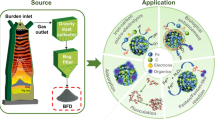Abstract
Industrial trials were carried out, using a fluidized-bed roaster, to investigate the effect of the roasting time, roasting temperature, basicity, and CaCl2 dose on the removal rates of Zn and Pb from blast furnace dust. Increasing the roasting time improved the Zn and Pb removal rates, and the maximum amounts of the Zn and Pb removal were achieved within the first 30 min. Increasing the roasting temperature favored the facile removal of both Zn and Pb, but the effect of the roasting temperature on Pb removal was more obvious than that on Zn removal. When CaCl2 is added, CaCl2 reacts with ZnO and PbO in the ore to form ZnCl2 and PbCl2, respectively. They are discharged along with sintering gas. Therefore, both the Zn and Pb removal rates improved evidently when CaCl2 was added, especially when the added amount of CaCl2 was in the range of 10–12%. Removal rates of up to 96% were achieved for Zn, while Pb removal rates of higher than 80% were achieved. During the sintering process, silicon and iron which are in the form of oxide negative ions will form complex compounds with zinc. This can make zinc removal difficult. If CaO is added as flux, the basicity increases and Ca replaces Zn, alleviating this problem of difficulty in Zn removal. Thus, upon increasing the basicity, the removal rate of Zn is improved, especially, increasing the basicity from 0.8 to 1.4 improved the Zn removal rate significantly.














Similar content being viewed by others
References
Shi X (2015) A brief introduction to the development of blast furnace gas purification system. Metall Econ Manag 1:38–39
Kai T, Zhang Y, Li S, Yang J, Xiao H, He X (2014) Laboratory test and research about extracting iron and zinc from blast furnace dust. Hebei Metall 3:1–5
Li L, Li K (2009) Recovery of iron and zinc from blast furnace sludge. Chin J Process Eng 19:468–473
Lanzerstorfer C (2016) Air classification of blast furnace dust catcher dust for zinc load reduction at the sinter plant. Int J Environ Sci Technol 13:755–760
Cong S, Li C (2011) Research status of gas ash recycling utilization. Technol Dev Chem Ind 40:55–58
Bronson TM, Ma N, Zhu L, Sohn HY (2017) Oxidation and condensation of zinc fume from Zn–CO2–CO–H2O streams relevant to steelmaking off-gas systems. Metall Mater Trans B 48B:908–921
Zhang Y, Kasai E (2004) Effect of chlorine on the vaporization behavior of zinc and lead during high temperature treatment of dust and fly ash. ISIJ Int 44:1457–1468
Lanzerstorfer C, Kröppl M (2014) Air classification of blast furnace dust collected in a fabric filter for recycling to the sinter process. Resour Conserv Recycl 86:132–137
Shi X, Liu Z (2003) Heat supply optimization of blend burning of ails and blast furnace gases in the rolling heating furnace. Metall Energy 22:27–29
Asadi Zeydabadi B, Mowla D, Shariat MH, Fathi Kalajahi J (1997) Zinc recovery from blast furnace flue dust. Hydrometallurgy 47:113–125
Yin H, Zhang J (2010) Study on the law of zinc absorption and change of metallurgical property of sinter and pellet. Iron Steel 45:15–18
Guo G, Gu W, Wu J (2010) Reduction and volatilization treatment of Zn-bearing blast furnace dust. Guizhou Sci 28:105–107
Gu W, Guo G, Xie X, Wu J, Chen X (2011) Research of zinc dust treatments with reduction-volatilization process. China Nonferrous Metall 2:57–59
Wu S, Liu Y, Du J, Mi K, Lin H (2002) Experiment study of assimilation ability between iron ores and CaO. J Univ Sci Technol Beijing 24:258–261
Acknowledgements
The authors are grateful for support from the National Natural Science Foundation of China (Grant Numbers 51474085 and 51674023).
Author information
Authors and Affiliations
Corresponding author
Additional information
The contributing editor for this article was D. Panias.
Rights and permissions
About this article
Cite this article
Yang, S., Zhao, M., Li, J. et al. Removal of Zinc and Lead from Blast Furnace Dust in a Fluidized-Bed Roaster. J. Sustain. Metall. 3, 441–449 (2017). https://doi.org/10.1007/s40831-017-0134-4
Published:
Issue Date:
DOI: https://doi.org/10.1007/s40831-017-0134-4




